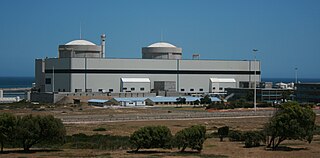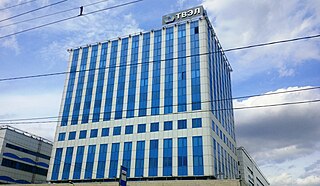
The pebble-bed reactor (PBR) is a design for a graphite-moderated, gas-cooled nuclear reactor. It is a type of very-high-temperature reactor (VHTR), one of the six classes of nuclear reactors in the Generation IV initiative.

Koeberg Nuclear Power Station is a nuclear power station in South Africa and the only one on the African continent. It is located 30 km north of Cape Town, near Melkbosstrand on the west coast. It is owned and operated by the country's state-owned electricity public utility, Eskom.

The Pebble Bed Modular Reactor (PBMR) is a particular design of pebble bed reactor developed by South African company PBMR (Pty) Ltd from 1994 until 2009. PBMR facilities include gas turbine and heat transfer labs at the Potchefstroom Campus of North-West University, and at Pelindaba, a high pressure and temperature helium test rig, as well as a prototype fuel fabrication plant. A planned test reactor at Koeberg Nuclear Power Station was not built.
Eskom Hld SOC Ltd or Eskom is a South African electricity public utility. Eskom was established in 1923 as the Electricity Supply Commission (ESCOM) (Afrikaans: Elektrisiteitsvoorsieningskommissie (EVKOM)). Eskom represents South Africa in the Southern African Power Pool. The utility is the largest producer of electricity in Africa, and was among the top utilities in the world in terms of generation capacity and sales. It is the largest of South Africa's state owned enterprises. Eskom operates a number of notable power stations, including Matimba Power Station and Medupi Power Station in Lephalale, Kusile Power Station in Witbank, Kendal Power Station, and Koeberg Nuclear Power Station in the Western Cape Province, the only nuclear power plant in Africa.

Pelindaba is South Africa's main nuclear research centre, run by the South African Nuclear Energy Corporation. It is situated south-east of the Hartbeespoort Dam, approximately 33 km (22 miles) west of Pretoria, on the farm that once belonged to Gustav Preller. During the apartheid era, it was the location where South Africa's atomic bombs were partially developed and constructed.
The Koeberg Alert alliance is an anti-nuclear activist organisation which emerged from an earlier pressure group in Cape Town called "Stop Koeberg" in 1983. Both were intended to halt construction of the first nuclear power station in South Africa at Duynefontein, 28 km NNW of Cape Town: the Koeberg Nuclear Power Station.

The South African Nuclear Energy Corporation (Necsa) was established as a public company by the Republic of South Africa Nuclear Energy Act in 1999 and is wholly owned by the State.
The Cape Town Ecology Group was a South Africa-based radical environmental group, founded in 1987, as a "child of Koeberg Alert", and active until the early 1990s. It espoused a more political-oriented green ideology as opposed to the apartheid-based conservation groups of the time. According to founder Mike Cope: "We felt the need to view ecological issues on a broader level and recognised the connection between politics and ecology. Ecology is definitely a political issue because environmental issues are about where we live."

The environmental movement in South Africa traces its history from the beginnings of conservation and preservation groups in the late 19th century, to the rise of radicalism amongst local ecologists and activists. The early environmental movement in South Africa was primarily made up of conservation groups whose membership was dominated by affluent whites. Many of these groups advocated for forms of fortress conservation that were used to justify forcibly removing Black South Africans from their land. Throughout the mid to late 20th century, justice-centered environmental groups sprung up in connection with anti-apartheid movements advocating for change on issues that affected the environment as well as the rights of workers and rural peoples, showing how environmental issues in the country were "inextricably linked to issues of race and politics."

The TVEL Fuel Company (TVEL) is a Rosatom-owned nuclear fuel cycle company headquartered in Moscow. It has operated since 1996.
Robert Martin Adam is the director of the Square Kilometer Array (SKA) radio-telescope in South Africa. He used to be the chief-executive officer of the South African Nuclear Energy Corporation (NECSA). and Director General of the South African Department of Science and Technology. He has worked as a consultant to the governments of Namibia and Chile, and is a Fellow of the Royal Society of South Africa.

As a member of the nuclear non-proliferation treaty, South Africa uses nuclear science for peaceful means. South Africa's nuclear programme includes both nuclear energy and nuclear medicine. In the past there was also a military component, and South Africa previously possessed nuclear weapons, which were subsequently dismantled.
The natural environment, commonly referred to simply as the environment, includes all living and non-living things occurring naturally on Earth.

South Africa is the only country in Africa with a commercial nuclear power plant.

South Africa has a large energy sector, being the third-largest economy in Africa. The country consumed 227 TWh of electricity in 2018. The vast majority of South Africa's electricity was produced from coal, with the fuel responsible for 88% of production in 2017. South Africa is the 7th largest coal producer in the world. As of July 2018, South Africa had a coal power generation capacity of 39 gigawatts (GW). South Africa is the world's 14th largest emitter of greenhouse gases. South Africa is planning to shift away from coal in the electricity sector and the country produces the most solar and wind energy by terawatt-hours in Africa. The country aims to decommission 34 GW of coal-fired power capacity by 2050. It also aims to build at least 20 GW of renewable power generation capacity by 2030. South Africa aims to generate 77,834 megawatts (MW) of electricity by 2030, with new capacity coming significantly from renewable sources to meet emission reduction targets. Through its goals stated in the Integrated Resource Plan, it announced the Renewable Energy Independent Power Producer Procurement Programme, which aims to increase renewable power generation through private sector investment.

The Electricity sector in South Africa is an important part of energy in South Africa. Most power stations in South Africa are owned and operated by the state owned enterprise, Eskom. These plants account for 80% of all the electricity produced in South Africa and 45% of all electricity produced on the African continent.
Makoma Lekalakala is a South African activist who is the director of the Johannesburg branch of Earthlife Africa. Along with Liz McDaid, she was awarded the 2018 Goldman Environmental Prize for the African region for their work on using the courts to stop a Russian-South African nuclear deal in 2017.
Liz McDaid is a South African activist who is the "Eco-Justice Lead" for the Southern African Faith Communities' Environment Institute (SAFCEI). Along with Makoma Lekalakala, she was awarded the 2018 Goldman Environmental Prize for the African region for their work on using the courts to stop a Russian-South African nuclear deal in 2017. In 2018 McDaid and Lekalakala received the Nick Steele Memorial Award for their work in winning a crucial court case to halt plans by the South African government to proceed with a national nuclear build programme. McDaid is currently Head of Energy at Organisation Undoing Tax Abuse.











